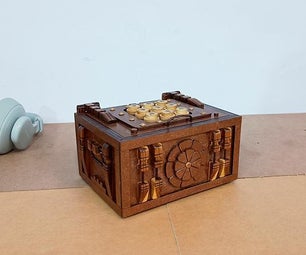Introduction: DIY Succulent Planter
Most of us have a piece or two of plywood lying around that is simply too small for most projects. However, you can grab a few of these and make cool angled planters out of them... This is a great beginner project as it requires just very basic woodworking. It is also fantastic because you can take all these miscellaneous pieces of plywood and make something nice and useful out of them. The holiday season is upon us and these succulent planters could be a very nice Christmas gift...
Supplies
- Plywood scraps
- Mine were approximately 120x90x16 mm...
- Table saw/mitre saw/band saw
- Some kind of sander
- Drill press
- Wood glue
- 3D printer (optional)
Step 1: Glue the Pieces Together
Firstly, we need to make a bigger block out of the plywood scraps.
Put enough wood glue on to nicely cover the mating surfaces, clamp the pieces together and let it dry. I ended up with a piece that is approximately 120x90x90 mm.
Step 2: Cut the Rough Shape
Now, it is time to cut the rough shape of the planter using a saw. I used a table saw and set the blade as well as the mitre gauge to an angle. The exact angle really doesn't matter as we are merely trying to make an attractive looking angled block, just set it to what looks right. This way, we can rough out the desired shape very quickly. This step could also be done with a mitre saw or band saw.
The piece we are working with is fairly small, therefore, at times your hands might be too close to the saw blade. I would recommend clamping the workpiece down instead of holding it with your hand and definitely use a push stick.
Step 3: Drilling the Hole
This succulent planter will hold a ⌀ 49 mm plant pot, so we are drilling a hole in the centre with a 50 mm Forstner bit 40 mm deep. Even though you might be able to do it with a cordless drill, a drill press is the best tool for the job. The workpiece needs to be adequately secured eider way, definitely use two clamps or vice with soft jaws.
Step 4: Sanding It Smooth
Now we can sand the succulent planter. In this step, you can basically use any sanding tool you have. I have started with a disk sander and 80 grid sandpaper. I cleaned up the surfaces to remove any saw marks and added a few extra chamfers to make it look nice. Then all the surfaces were sanded smooth with a random orbit sander and 180 grid sandpaper. At last, I lightly sanded over any sharp corners by hand using a 600 grid sandpaper.
Step 5: Applying the Finnish
The last step is to apply the finish. You can basically use anything you have got on hand. I applied linseed oil because in my opinion it gives a nice contrast to the lines and makes it look great. Arguably, varnish or spray lacquer would protect the planter from moisture better. However, as you don't really need to water these plants a lot anyway, this should not be a problem.
Step 6: Making Plant Pots
I decided to 3D print the plant pots out of PLA. It is just a hollow cylinder with an outer diameter of 49 mm and 40 height. I printed at 225 °C on the nozzle which is quite hot for PLA, this should ensure that the pots are watertight.
If you don't have access to a 3D printer you can, for example, get these stainless steel shot glasses on Amazon and use them as plant pots.
Step 7: We Are DONE
There we go! We have taken something that was a piece of trash and made something useful out of it. A lovely succulent planter that lights up any space you put it in.
Thank you for reading this far and if you want even more information check out the DIY succulent planters video...











